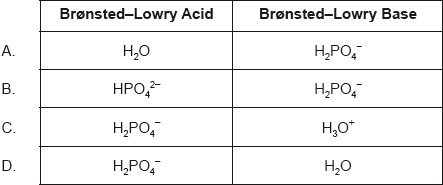| Date | May 2019 | Marks available | 1 | Reference code | 19M.2.sl.TZ2.5 |
| Level | SL | Paper | 2 | Time zone | TZ2 |
| Command term | State | Question number | 5 | Adapted from | N/A |
Question
Carbonated water is produced when carbon dioxide is dissolved in water under pressure.
The following equilibria are established.
Carbon dioxide acts as a weak acid.
Soda water has sodium hydrogencarbonate, NaHCO3, dissolved in the carbonated water.
Distinguish between a weak and strong acid.
Weak acid:
Strong acid:
The hydrogencarbonate ion, produced in Equilibrium (2), can also act as an acid.
State the formula of its conjugate base.
When a bottle of carbonated water is opened, these equilibria are disturbed.
State, giving a reason, how a decrease in pressure affects the position of Equilibrium (1).
Predict, referring to Equilibrium (2), how the added sodium hydrogencarbonate affects the pH.(Assume pressure and temperature remain constant.)
100.0 cm3 of soda water contains 3.0 × 10−2 g NaHCO3.
Calculate the concentration of NaHCO3 in mol dm−3.
Identify the type of bonding in sodium hydrogencarbonate.
Between sodium and hydrogencarbonate:
Between hydrogen and oxygen in hydrogencarbonate:
Markscheme
Weak acid: partially dissociated/ionized «in solution/water»
AND
Strong acid: «assumed to be almost» completely/100 % dissociated/ionized «in solution/water» [✔]
CO32– [✔]
shifts to left/reactants AND to increase amount/number of moles/molecules of gas/CO2 (g) [✔]
«additional HCO3–» shifts position of equilibrium to left [✔]
pH increases [✔]
Note: Do not award M2 without any justification in terms of equilibrium shift in M1.
«molar mass of NaHCO3 =» 84.01 «g mol–1» [✔]
«concentration = » 3.6 × 10–3 «mol dm–3» [✔]
Note: Award [2] for correct final answer.
Between sodium and hydrogencarbonate:
ionic [✔]
Between hydrogen and oxygen in hydrogencarbonate:
«polar» covalent [✔]
Examiners report
It was rather disappointing that less than 70 % of the candidates could distinguish between weak and strong acids. Many candidates referred to pH differences.
A poorly answered question, though it discriminated very well between high-scoring and low-scoring candidates. Less than 40 % of the candidates were able to deduce the formula of the conjugate base of HCO3-. Wrong answers included water, the hydroxide ion and carbon dioxide.
This was a relatively challenging question. Only about a quarter of the candidates explained how a decrease in pressure affected the equilibrium. Some candidates stated there was no shift in the equilibrium as the number of moles is the same on both sides of the equation, not acknowledging that only gaseous substances need to be considered when deciding the direction of shift in equilibrium due to a change in pressure. Some candidates wrote that the equilibrium shifts right because the gas escapes.
This was one of the most challenging questions on the paper that required application of Le Chatelier’s Principle in an unfamiliar situation. Most candidates did not refer to equilibrium (2), as directed by the question, and hence could not gain any marks. Some candidates stated that NaHCO3 was an acid and decreased pH. Some answers had contradictions that showed poor understanding of the pH concept.
Very well answered. Most candidates calculated the molar concentration correctly.
Many candidates identified the bonding between sodium and hydrogencarbonate as ionic. A much smaller proportion of candidates identified the bonding between hydrogen and oxygen in hydrogencarbonate as covalent. The most common mistake was “hydrogen bonding”.


